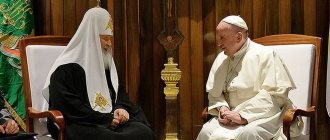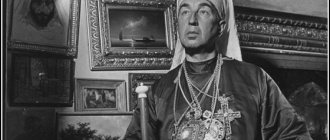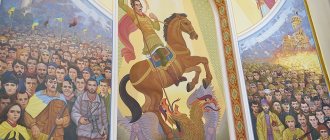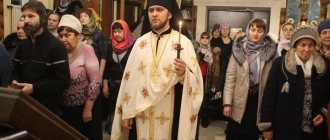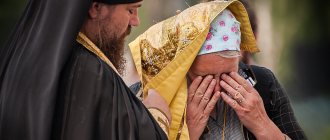The Orthodox world is on the threshold of the Great Schism
The division of Local Churches has already become a sad reality in 2018, however, the absolute majority of Orthodox Christians maintain unity
The theological teaching about church boundaries, the relationships of Local Churches, including what division can be considered a schism, is called “ecclesiology” (“ecclesiology”). It comes from the Greek word “ἐκκλησία” (“assembly”, “Church”) and gives an understanding of what originally originated in the Roman Empire (Byzantine Empire) in the first centuries of Christianity, being reflected in the acts of the seven Ecumenical Councils.
Every church-going Christian who takes part in the Sacraments and conciliar liturgical prayers knows very well the definition of the Church, which is included in one of the main Christian liturgical texts - the “Creed”: “... I believe... in the One Holy, Catholic and Apostolic Church.” Without this faith, we can call ourselves whatever we want, “conservatives” and “liberals,” “social Christians” or even “Orthodox monarchists,” but we cannot be Orthodox Christians. Just as without the belief that our Russian Orthodox Church is an integral part of the mentioned Church of the “Creed”.
And at the same time, throughout New Testament times, divisions occurred among people who affirmed their faith in Christ and His Church. These divisions could be insignificant, not affecting the key foundations of the Christian faith and church structure (and then, according to the apostle, they helped identify the “most skilled” in theology). But very often divisions led to schisms and heresies, inflicting serious wounds on the Church Body, which, according to the firm conviction of Christians, is the Body of Christ Himself.
On the other hand, for everyday conveniences, the One Holy Catholic and Apostolic Church has been divided since ancient times into Local, Autocephalous Churches. Independent in administrative, financial and similar technical matters, allowing for certain ethnic traditions in liturgical practice, but spiritually united with other Orthodox Churches.
Meeting of Primates of Local Orthodox Churches. January 2016. Photo: patriarchia.ru
Such divisions are the norm for the Orthodox world, but in history they have repeatedly balanced on the brink of real schisms, mainly associated with ethno-phyletic (nationalist) attitudes towards other Local Churches, as well as with conflict resolution of issues relating to the disputed boundaries of canonical territories.
Such conflicts, unfortunately, existed both in ancient times and in our days, but on the whole they did not destroy the architecture of the Orthodox world. And if the Great Schism of 1054 separated the West, which had fallen into the Latin heresy, from the Christian East, then the absolute majority of the Eastern Churches remained faithful to Holy Orthodoxy. Also in the second half of the 17th century, church reform led to a tragic Schism in the Russian Church, significantly weakening Russian civilization, but preserving its churchliness (despite a number of erroneous reforms in a Westernizing spirit). And only the Ukrainian schism, which began in the tragic 20th century, in the 21st century brought the entire Orthodox ecumene to the brink of schism.
But what does this Orthodox ecumene represent today? What is the significance and influence of certain Local Churches, and how can they behave in the event that in the coming days the Patriarchate of Constantinople (Phanar), through entering into anti-canonical unity with Ukrainian pseudo-Orthodox nationalist sects, finally breaks with patristic Orthodoxy?
Let’s try to understand all this by conducting a brief “revision” of the current state of the Orthodox Local Churches. However, we will do this not traditionally, according to the order in the “diptych” (the order of historical honor), but based on the real position of this or that Local Church in the world.
1. Russian Orthodox Church – Church of the Third Rome
In the diptych of Orthodox Local Churches, the Moscow Patriarchate (the names “Russian Orthodox Church” and “Moscow Patriarchate” are equivalent and do not require mutual addition) occupies only fifth place. Although, if we take into account the current fall of the Patriarchate of Constantinople into schism, we automatically become fourth. And yet, it is important to understand that this place is a clear symbol of the fact that the Russian Church does not strive not only for the primacy of power, but also for the primacy of honor.
Photo: www.globallookpress.com
Despite the fact that from the middle of the 15th century, when the Church of Constantinople first fell into the Florentine Union with the Roman Catholics (1439), and then Constantinople itself fell under the blows of the Ottoman Turks (1453), it was the Russian Church that became the first in its influence and significance in the world, we humbly retained our subsidiary status. And when the Church of Constantinople returned to Orthodoxy again, the Moscow Metropolis, which then received the status of Patriarchate, acquired autocephaly precisely from the Church of Constantinople (first, in 1448, voluntarily, separating from Constantinople, which had fallen into heresy, and then, in the 16th century, officially).
Today, the Russian Orthodox Church is the largest and most influential in the family of Orthodox Local Churches. Despite the monstrous damage inflicted on our Church in the 20th century, today about 40 thousand full-time clergy (a little less than 35 thousand priests, a little less than 5 thousand deacons and over 400 bishops) serve in the Moscow Patriarchate. A significant part of the parishes (about a third), as well as bishops (about one fifth) of the Russian Orthodox Church are located on the territory of Ukraine and are part of the self-governing Ukrainian Orthodox Church (part of the Moscow Patriarchate with the rights of the broadest autonomy). According to the Primate of our Church, His Holiness Patriarch Kirill of Moscow and All Rus':
The Russian Orthodox Church is not the Church of the Russian Federation, but the Church of many peoples united by history, spiritual and cultural origins, and common moral values.
Russian Orthodox Church – Church of the Third Rome. Photo: patriarchia.ru
In addition to Russia, the canonical territory of the Moscow Patriarchate is the entire post-Soviet space (with the exception of Georgia, which has its own autocephalous Georgian Orthodox Church, as well as Armenia, since we maintain good neighborly relations with the Armenian Apostolic Church, despite its difference from the Orthodox Churches), Japan , China, Mongolia and the Russian diaspora in foreign countries. Regarding some countries and territories, including long-suffering Ukraine, the Russian Orthodox Church has controversial situations with other Local Churches.
2. Romanian Orthodox Church
Despite the deep and sincere churching of millions of Orthodox Romanians, deep monastic life (there are over 350 monasteries in Romania), the hierarchy of the Romanian Church is distinguished by liberal-renovationist and ecumenical positions. Moreover, at the very beginning of the 1990s, the Romanian Patriarchate created the schismatic “Bessarabian Metropolis” on the territory of post-Soviet Moldova, the existence of which is a serious point of conflict between the Russian and Romanian Churches.
The Romanian Patriarchate is one of the youngest in terms of acquiring autocephaly (proclaimed in 1865, recognized by the Church of Constantinople in 1885). In the diptych of Local Churches, we recognize the 8th place of the Romanian Orthodox Church (7th taking into account the schism of the Patriarchate of Constantinople). But in terms of the number of clergy, churches and monasteries, this is the second Local Church in the world after the Russian Church (over 15 thousand parishes and more than 50 bishops).
Visit of His Holiness Patriarch Kirill to Romania. October 2021. Photo: patriarchia.ru
It is difficult to say what position the Romanian Patriarch Daniel (Ciobotea) will take if the Patriarchate of Constantinople finally enters into communion with the Ukrainian schismatics, but today this particular Church is one of the weakest links in World Orthodoxy. The only thing that can stop the Romanian hierarchs from falling into schism along with the Phanar is their reluctance to share their own autocephaly with the Patriarchate of Constantinople.
3. Hellenic (Greek) Orthodox Church
State Church of Greece (currently the left-liberal government is trying to deprive the Church of this status). 11th (10th) in the diptych of Local Churches. Quite numerous and influential, but limited to the territory of Greece (and part of the northern and island territories are subject to the Patriarchate of Constantinople).
Visit of His Holiness Patriarch Kirill to Greece. Solemn meeting of the Synod of the Greek Orthodox Church. June 2013. Photo: patriarchia.ru
About 150 hierarchs (their number is clearly disproportionate to the 9 million flock) of the Greek Church value their autocephaly, but the Church itself is mentally close to the Constantinople, and therefore its break with the Phanar due to the Ukrainian incident is unlikely.
Nevertheless, it is worth remembering that in the Greek Church there are also very conservative-minded hierarchs who have already criticized the Phanar quite harshly more than once. Moreover, in Greece (as well as Romania) the ultra-conservative Old Calendarist movement is very strong. And if the Phanar continues to assert itself in its ortho-liberal vector, the Greek Church may decide on an alternative position based on a more solid adherence to the patristic tradition.
4. Serbian Orthodox Church
Visit of His Holiness Patriarch Kirill to the Serbian Orthodox Church. November 2014. Photo: patriarchia.ru
The closest to the Moscow Patriarchate of all the Local Churches. It occupies 7th (6th) place in the diptych, but in reality it spiritually nourishes over 10 million Orthodox Serbs and Montenegrins. Also, the canonical territory of the Serbian Church is the Republic of Macedonia, however, the schismatic “Macedonian Orthodox Church” operates in the latter. There is practically no doubt that in the event of a schism in World Orthodoxy, the Serbian Orthodox Church will remain together with the Russian Church.
5. Bulgarian Orthodox Church
Visit of His Holiness Patriarch Kirill to Bulgaria. Ceremony on the occasion of the National Day of the Republic of Bulgaria on Mount Shipka. March 2021. Photo: patriarchia.ru
This Church, located in 9th (8th) place in the diptych of Local Churches, caring for over 7 million Bulgarians, is also very close to the Russian Orthodox Church. However, political pressure on the leadership of this Church is more significant than on the Serbian Church. Unfortunately, Bulgaria is a NATO member country and almost the entire political elite of this state is integrated into the Western system.
It is difficult to answer whether this will affect the position of the Bulgarian hierarchy in the event of a hard choice between Phanar and Moscow, but in the episcopate of the Bulgarian Church there are clear supporters of the Russian Orthodox Church who, most likely, will not allow the Synod to take the position of the Patriarchate of Constantinople.
6. Antiochian Orthodox Church
His Beatitude Patriarch John X of Great Antioch and All the East and His Holiness Patriarch Kirill of Moscow and All Rus' in the Cathedral of Christ the Savior. February 2015. Photo: patriarchia.ru
One of the most ancient Local Churches (3rd, and excluding Phanar, 2nd place in the diptych). Church of Orthodox Arabs of Syria, Lebanon and a number of surrounding countries (flock - about 2 million people). It is in very close relations with the Russian Orthodox Church. There is no doubt about her support for our position on the issue of the Ukrainian split.
7. Alexandria Orthodox Church
Meeting of His Holiness Patriarch Kirill with His Beatitude Patriarch Theodore II of Alexandria. July 2021. Photo: patriarchia.ru
At the moment, it is the first in the diptych, given that Phanar has fallen into schism. Spiritually nourishes the entire territory of Africa. Pope and Patriarch of Alexandria and all Africa Theodore II takes a conciliatory position on the issue of relations between Moscow and Phanar, but categorically does not accept the support of Ukrainian nationalists. It is hoped that the Greek origin of a significant part of the episcopacy of the Alexandrian Church will not influence its support for the iniquities of the Patriarchate of Constantinople.
8. Jerusalem Orthodox Church
Visit of His Holiness Patriarch Kirill to the Jerusalem Patriarchate. Joint worship with Theophilus III, Patriarch of the Holy City of Jerusalem and all Palestine, Syria, Arabia, all Transjordan, Cana of Galilee and Holy Zion. November 2012. Photo: patriarchia.ru
The most ancient Church, which has the right to claim 1st place in the diptych, however, historically it occupies only 4th (3rd in today's circumstances). Unfortunately, most of the episcopate is of Greek origin and has close ties to the Phanar. It is very difficult to predict the position of the Church of the holy city of Jerusalem in the conflict between the Moscow Patriarchate and the Patriarchate of Constantinople, but there is a fear that the bishops of the Jerusalem Patriarchate, engaged by the West and the State of Israel, may take the side of the Phanar. Although, for example, Archbishop Theodosius of Sebaste (bishop of the Jerusalem Patriarchate) takes a clearly pro-Moscow position.
9. Georgian Orthodox Church
Meeting of His Holiness Patriarch Kirill with His Holiness and Beatitude Catholicos-Patriarch of All Georgia Ilia II. November 2021. Photo: patriarchia.ru
Geographically and historically close to the Russian Orthodox Church (in the diptych it follows immediately after the Moscow Patriarchate). However, our relations are seriously complicated by the political processes of recent decades. Nevertheless, the Moscow Patriarchate formally still recognizes the Republics of Abkhazia and South Ossetia as canonical territories of the Georgian Church. It is this fact that leaves hope that in the event of a radical break with the Phanar, we will maintain unity with the Georgian Patriarchate.
10. Albanian Orthodox Church
Visit of His Holiness Patriarch Kirill to Albania. Meeting with His Beatitude Archbishop Anastasius of Tirana and all Albania. April 2021. Photo: patriarchia.ru
A church very close to Phanar. Occupies 12th (11th) place in the diptych. Formally autocephalous, but in reality not independent. In almost all external church issues he takes the side of the Patriarchate of Constantinople.
11. Cypriot Orthodox Church
Meeting of His Holiness Patriarch Kirill with His Beatitude Archbishop of New Justiniana and all Cyprus Chrysostomos II. December 2017. Photo: patriarchia.ru
Also very close to Phanar. The Church is ancient, occupying the 10th (9th) place in the diptych, but its formal autocephaly is largely limited to the Patriarchate of Constantinople, of which the Church of the Island of Cyprus is, in fact, an autonomous branch.
12. Polish Orthodox Church
Visit of His Holiness Patriarch Kirill to Poland. A visit, together with His Beatitude Metropolitan Sava of Warsaw and all Poland, to the Memorial to Soviet Soldiers-Liberators and the Tomb of the Unknown Soldier in Warsaw. August 2012. Photo: patriarchia.ru
The Church of Orthodox Poles, as well as the East Slavic Rusyns, Lemkos, Belarusians and part of the Polish Little Russians related to the Russians. In the diptych it is only in the 13th (12th) place, but it is relatively numerous, spiritually nourishing over half a million Orthodox Christians (and according to some sources, more than a million). She is very close to the Russian Orthodox Church, there is no doubt about her support, especially considering the extremely negative attitude in this Church towards Ukrainian nationalism.
13. Orthodox Church of the Czech Lands and Slovakia
Meeting of His Holiness Patriarch Kirill with the Primate of the Orthodox Church of the Czech Lands and Slovakia, Metropolitan Rostislav (Gont). Photo: patriarchia.ru
A small Confessor Church, subject to serious pressure from the Phanar. Over the past years, the Patriarchate of Constantinople has tried to carry out a revolution in this Church, practically depriving it of autocephaly. And only the support of the Orthodox Slavic brothers from the Russian Orthodox Church allowed the Orthodox Slovaks and Czechs to independently elect their Primate. He is 40-year-old Metropolitan Rostislav (Gont), a man of Rusyn origin, spiritually very close to the Moscow Patriarchate.
14. Orthodox Church in America
The autocephaly of this Church is recognized only by the Russian, Bulgarian, Georgian, Polish Churches, as well as the Church of the Czech Lands and Slovakia. The Patriarchate of Constantinople, which claims the exclusive right to care for Orthodox Christians in the Diaspora, does not recognize the existence of this Church at all. Therefore, on the issue of the schism of the Orthodox world due to the iniquities of the Phanar, the position of the Orthodox Church in America does not matter, but its unity with the Russian Church is not questioned.
Meeting of His Holiness Patriarch Kirill with His Beatitude Metropolitan Tikhon of All America and Canada. December 2021. Photo: patriarchia.ru
In conclusion, it is worth saying that all the forecasts presented are very approximate and preliminary. It is too early to say what will happen as a result of the Kyiv “Wolf Council” on December 15, 2021. But, in any case, every Orthodox Christian should pray “for the peace of the whole world, the prosperity of God’s holy Churches and the unity of all.” And whatever our political views, we have no right to rejoice at church divisions. Although the Orthodox world does not need mechanical unity. True Orthodox unity can only be found in patristic truth.
What is schism: concept and origin of the word
The concept of schism explains and interprets the ancient Greek language itself, and its definition is as follows: division, splitting, schism or, in simple terms, discord. And all this concerns, in the case of schism, not just some everyday human misunderstandings that occur from time to time in our lives.
Here, not just Ivan Ivanovich and Ivan Nikiforovich quarreled for several days, but, as a result, the excommunicated Patriarch of Constantinople himself and the representative of the Pope, Cardinal Humbert, quarreled, in fact, anathematizing each other - and for several centuries at once.
These historical characters have long been dead, but the great schism of the Christian Church still exists today. And instead of one Christian world, since then there have been two of them: Western Catholic and Eastern Orthodox.
Papal ambitions and the last reason for the schism
So, returning to the beginning of our story, let me remind you that the final reason for this was the conflict between the high priests: the Roman, Pope Leo the Ninth and the Byzantine: Patriarch of Constantinople Michael Cerullarius.
The Pope insisted that the Roman see was paramount and should be respected without complaint as a mother. However, Michael did not think so, believing that the see of Constantinople was by no means less important. Since this all started. Or rather, that’s how it all ended.
In the spring of 1054 Cardinal Humbert, who arrived as ambassador to Constantinople from Rome, was unable to cope with the mission entrusted to him. (And one of the points included reconciliation with Mikhail).
His unbridled temper and some, as sources testify, impudence led to the fact that the high-ranking people finally quarreled.
Results and consequences
In July 1054, representatives of the Roman Church went to the altar of St. Sophia Cathedral and began to denounce the holy Patriarch Michael of unrighteousness right during his divine service. And then they announced that the Eastern Patriarch was excommunicated from the church along with his followers, accusing him, in the process, of heresy.
The Patriarch was speechless with amazement. The people present also did not immediately recover from the shock, but, having come to their senses, they supported their ruler. Strong unrest arose, and representatives of Rome had to urgently leave Constantinople.
In turn, Cerularius also soon convened his Council, where he anathematized the papal supporters. This is how the Great Schism happened.
This is truly true: the West is the West - the East is the East: they will never be together.
Accordingly, the eastern patriarchates remained with Byzantium, the western with Rome. Since then, the Eastern Church began to be called Orthodox, the Western - Catholic.
Tsar or patriarch: who is more important?
Having received the tsar's full support for carrying out church reform, Patriarch Nikon set about implementing it with enviable zeal. The first official document instructing people to cross themselves with three fingers - the so-called “Memory” - was adopted in 1653. Many priests and representatives of the flock opposed this. However, the Church Council of 1656 officially approved the Greek canon of worship. And the split began.
Patriarch Nikon remained in history as a decisive, ambitious and tough man in defending his views. He believed that God's law was higher than the tsarist law, and saw the future of Russia in the creation of a theocratic state, when secular power was subordinated to religious power. His methods caused a negative attitude among the Moscow political elite of that time. Many boyars, dissatisfied with the strengthened power of the patriarch and his ambitions, sought to turn the king against Nikon. And they succeeded.
However, Alexey Mikhailovich himself was not going to share power with the patriarch. In 1658, relations between the heads of secular and spiritual power deteriorated completely. And Nikon defiantly left his post, retiring to the Resurrection Monastery. The clergyman hoped that under pressure from the flock, left without their spiritual leader, the tsar would be forced to beg him to return to the patriarchal throne. Alexey Mikhailovich did not do this.
The several years Nikon spent in the Resurrection Monastery clearly showed that Russia could well do without his spiritual leadership. The church council, held in 1666-1667 in Moscow, which was attended by the Patriarchs of Alexandria and Antioch, officially deprived Nikon of all his regalia. The ambitious clergyman was exiled to the remote Belozersky monastery.
However, the same council finally approved all the church reforms implemented by the deposed patriarch. And the Old Believers were equated with heretics. As a result, Russia remained a secular state, while at the same time positioning itself as a stronghold of Orthodoxy.
